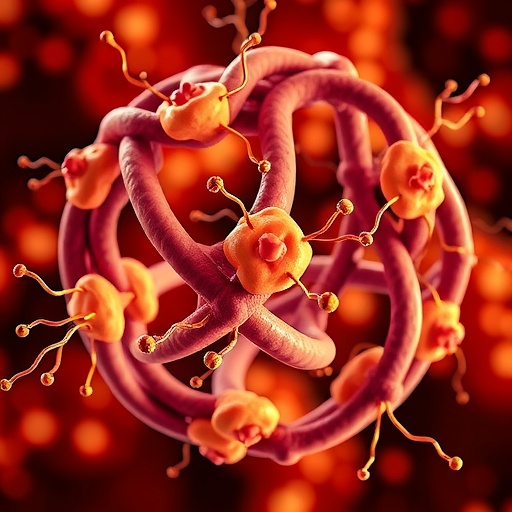In a groundbreaking study set to be published in the journal Molecular Diversity, researchers led by Pratik Samanta, along with Shubha Das and Debapriya Mandal, have made significant strides in understanding the terminal half-life of pharmaceuticals through the lens of chemometric modeling. This innovative approach not only sheds light on the intricate relationship between a drug’s chemical structure and its pharmacokinetic properties, particularly elimination rates, but also extends a strategic framework that pharmaceuticals can leverage in future therapeutic developments.
The terminal half-life of a drug plays a crucial role in its efficacy, safety, and overall therapeutic regimen. It provides vital information on how long a drug stays active in the body before it is metabolized and eliminated. Understanding this aspect can greatly affect dosing schedules and treatment outcomes, making the research a cornerstone in pharmaceutical development. The study meticulously illustrates how various chemical structures lead to different half-lives, ultimately affecting therapeutic strategies and patient outcomes.
The research team utilized advanced chemometric techniques—an intersection of chemistry and mathematics—to analyze large datasets containing diverse pharmaceutical compounds. By applying these sophisticated modeling techniques, the researchers were able to predict the terminal half-lives of various drugs, correlating their structural features with their elimination rates. This predictive model represents a monumental shift from traditional empirical methods, which often rely on time-consuming and expensive experimental procedures.
One of the most compelling facets of the study is its capacity to pave the way for personalized medicine. With the ability to predict how long a drug will act in an individual patient, clinicians can tailor dosing regimens that enhance therapeutic efficacy while minimizing potential side effects. This personalized approach not only improves patient compliance but also optimizes the therapeutic window of drugs, allowing for more precise treatment strategies that accommodate individual variability in drug metabolism.
Chemometric modeling is not solely confined to predicting half-lives. The tools and algorithms deployed in this study can be adapted to explore other pharmacokinetic parameters such as absorption, distribution, metabolism, and excretion (ADME) properties. This multidimensional capability broadens the scope of pharmaceutical research, enabling scientists to develop comprehensive models that better predict a drug’s entire lifecycle within the human body.
As drug discovery becomes increasingly data-driven, the role of artificial intelligence and machine learning cannot be overstated. The models developed in this study could serve as a precursor to AI-driven platforms that continuously learn from new data and improve their predictive accuracy over time. This evolution encapsulates a vital transition in the scientific paradigm, where computational power and chemical diversity come together to expedite the drug discovery process.
The implications of this research extend to regulatory perspectives as well. Regulatory agencies are continuously seeking methods to enhance the approval process of new drugs. By providing a robust model to estimate half-life and associated pharmacokinetic parameters, this study could help streamline the approval of innovative therapies, thereby hastening the delivery of critical medications to patients in need. Furthermore, it could lead to more transparent and reliable data submissions, promoting trust between pharmaceutical companies and regulatory bodies.
Moreover, as the researchers delve into the dynamics of drug disposition, they also address the paradox of drug resistance. Understanding the factors influencing drug half-life can aid in developing strategies to circumvent resistance mechanisms that often hamper the efficacy of treatments for chronic diseases such as cancer. By fine-tuning pharmacokinetic profiles, clinicians may be able to overcome pharmacological barriers and enhance drug responsiveness.
The journey from structure to strategy is not merely academic; it holds the potential to affect millions of lives globally. The research highlights the vital intersection of structural chemistry and computational modeling, emphasizing the importance of harnessing interdisciplinary approaches in modern scientific research. This convergence could catalyze far-reaching changes not only in the pharmaceutical industry but also in the broader healthcare landscape.
Furthermore, the ethical considerations surrounding drug development cannot be ignored. More efficient models that predict pharmacokinetic properties could allow for reduced animal testing, aligning with the growing demand for humane and ethical approaches in the biomedical sciences. By advancing computational techniques, researchers can mitigate the need for extensive experimental trials, thereby fostering a culture of responsibility within the industry.
In conclusion, the work of Samanta and colleagues presents a transformative opportunity for the pharmaceutical industry. By leveraging chemometric modeling to analyze the terminal half-lives of pharmaceuticals, their research not only adds depth to our understanding of drug properties but also sets a trajectory for future innovations in therapeutics. The study opens the door to tailored medicine and fortifies the necessary bridge between chemistry and clinical application. As the scientific community absorbs these findings, we stand on the brink of a new era in drug development—one where precision meets efficiency, ultimately leading to improved patient outcomes globally.
As the field of pharmacology evolves, it is crucial for stakeholders across the spectrum—from scientists and regulatory bodies to clinicians and patients—to stay abreast of these developments. The pioneering research by Samanta, Das, and Mandal offers a compelling blueprint for future exploration, inviting further inquiry into how chemical structure can dictate therapeutic outcomes and pressing the case for a more integrated approach to drug design.
The challenges ahead are significant, but the potential rewards are even greater. As we endeavor to unravel the complexities of drug action within the human body, the insights garnered from this study will surely illuminate the path forward, helping us to navigate the intricate dance between structure and function in the realm of pharmaceuticals.
Subject of Research: Chemometric modeling for the prediction of terminal half-life of pharmaceuticals.
Article Title: From structure to strategy: chemometric modeling for the prediction of terminal half-life of pharmaceuticals and its role in future therapeutics.
Article References: Samanta, P., Das, S., Mandal, D. et al. From structure to strategy: chemometric modeling for the prediction of terminal half-life of pharmaceuticals and its role in future therapeutics. Mol Divers (2025). https://doi.org/10.1007/s11030-025-11322-3
Image Credits: AI Generated
DOI: 10.1007/s11030-025-11322-3
Keywords: Chemometric modeling, pharmacokinetics, terminal half-life, drug development, personalized medicine, drug resistance, artificial intelligence, regulatory science.
Tags: advanced chemometric techniqueschemometric modeling in pharmaceuticalsdosing schedules and treatment outcomesimpact of drug half-life on efficacyinnovative approaches in therapy developmentmathematical modeling in drug researchpharmaceutical development strategiespharmacokinetic properties analysispredicting drug half-liferelationship between drug structure and elimination ratesstructural features affecting drug metabolismterminal half-life of drugs





